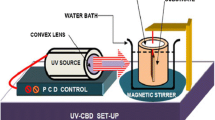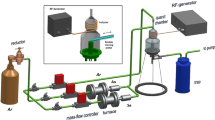Abstract
The electric and photoelectric properties of gallium-arsenide films deposited on a polycrystalline corundum substrate from the ablation plasma formed by a high-power ion beam are investigated. It is ascertained that vacuum and air annealing (in the former case, P = 10−2 Pa and T = 300–1200 K) and sulfide chemical passivation in an alcoholic solution affect the characteristics of the dark conductivity and photo-conductivity of the film surfaces. The optimal conditions for thermal and chemical treatment, at which the most stable changes in film the properties are attained, are determined. Enhancement in the stability of the electrical and photoelectric characteristics of films, which is achieved after thermal treatment, arises from the annealing of defects and their clusterization. Sulfide passivation leads to changes in the characteristics and increases the stability of properties under air oxidation.
Similar content being viewed by others
References
L. S. Lunin and A. S. Pashchenko, Tech. Phys. 56, 1291 (2011).
A. P. Gorshkov, I. A. Karpovich, D. O. Filatov, et al., J. Surf. Invest.: X-ray, Synchrotron Neutron Tech. 5, 563 (2011).
A. Jaouad, V. Aimez, and Ç. Aktik, Electron. Lett. 40, 1024 (2004).
V. L. Alperovich, O. E. Tereshchenko, N. S. Rudaya, et al., Appl. Surf. Sci. 235, 249 (2004).
C. L. Hinkle, A. M. Sonnet, E. M. Vogel, et al., Appl. Phys. Lett. 91, 163512 (2007).
E. F. Venger, S. I. Kirillova, and V. E. Primachenko, Semiconductors 33, 1088 (1999).
V. G. Bozhkov, V. A. Kagadei, and N. A. Torkhov, Semiconductors 32, 1196 (1998).
Y. Wu, Y. Liu, X. M. Ding, et al., Appl. Surf. Sci. 228, 5 (2004).
J. Riikonen, J. Sormunen, H. Koskenvaara, et al., J. Cryst. Growth 272, 621 (2004).
K.-P. Hsueh, H.-Ts. Hsu, Ch.-H. Wu, and Yu.-M. Hsin, Semicond. Sci. Technol. 19, L118 (2004).
V. Ortiz, J. Nagle, J.-F. Lampin, et al., J. Appl. Phys. 102, 043515-1 (2007).
Masafumi Jo, Takaaki Mano, and Kazuaki Sakoda, Appl. Phys. Express 3, 045502 (2010).
V. M. Mikoushkin, Yu. S. Gordeev, S. Yu. Nikonov, et al., Phys. Status Solidi C 6, 2655 (2009).
X. M. Teng, H. T. Fan, S. S. Pan, et al., J. Vac. Sci. Technol. A 24, 1714 (2006).
H. Reuter, H. Schmitt, and M. Boffgen, Thin Solid Films 254, 96 (1995).
U. Coscia, R. Murri, N. Pinto, and L. Trojani, J. Non-Cryst. Solids 194, 103 (1996).
J. H. D. Da Silva, R. R. Campomanes, D. M. G. Leite, et al., J. Appl. Phys. 96, 7052 (2004).
F. A. Abdel-Wahab and M. F. Kotkata, Physica B 368, 209 (2005).
A. Erlacher, M. Ambrico, V. Capozzi, et al., Semicond. Sci. Technol. 19, 1322 (2004).
V. S. Lopatin, G. E. Remnev, E. G. Furman, et al., Instrum. Exp. Tech. 47, 484 (2004).
V. K. Struts, A. V. Petrov, V. M. Matvienko, et al., J. Surf. Invest.: X-ray, Synchrotron Neutron Tech. 5, 497 (2011).
A. V. Kabyshev, F. V. Konusov, and G. E. Remnev, J. Surf. Invest.: X-ray, Synchrotron Neutron Tech. 5, 228 (2011).
M. L. Dmitruk, O. I. Maeva, S. V. Mamykin, and O. B. Yastrubchak, Tech. Phys. Lett. 23, 355 (1997).
V. N. Bessolov and M. V. Lebedev, Semiconductors 32, 1141 (1998).
T. Simonsmeier, A. Ivankov, and W. Bauhofer, J. Appl. Phys. 97, 084910 (2005).
S. M. Avdeev, E. V. Erofeev, and V. A. Kagadei, Semiconductors 45, 1026 (2011).
E. V. Erofeev and V. A. Kagadei, Semiconductors 45, 1148 (2011).
N. A. Bert, A. I. Veinger, M. D. Vilisova, et al., Phys. Solid State 35, 1289 (1993).
X. Liu, A. Prasad, V. M. Chen, et al., Appl. Phys. Lett. 65, 3002 (1994).
G. Brammertz, H. C. Lin, K. Martens, et al., J. Electr. Soc. 155, H945 (2008).
Author information
Authors and Affiliations
Additional information
Original Russian Text © A.V. Kabyshev, F.V. Konusov, G.E. Remnev, 2014, published in Poverkhnost’. Rentgenovskie, Sinkhrotronnye i Neitronnye Issledovaniya, 2014, No. 2, pp. 68–73.
Rights and permissions
About this article
Cite this article
Kabyshev, A.V., Konusov, F.V. & Remnev, G.E. Thermal and chemical passivation of gallium-arsenide films deposited from ablation plasma. J. Surf. Investig. 8, 158–163 (2014). https://doi.org/10.1134/S1027451014010285
Received:
Published:
Issue Date:
DOI: https://doi.org/10.1134/S1027451014010285




